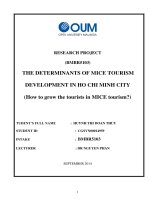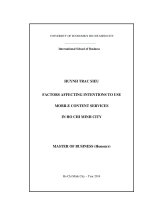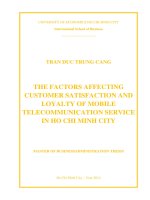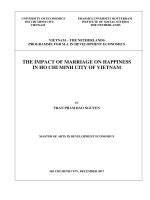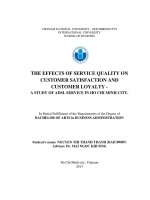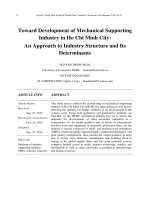The factors affecting customer satisfation and loyalty of mobile telecommucation service in ho chi minh city
Bạn đang xem bản rút gọn của tài liệu. Xem và tải ngay bản đầy đủ của tài liệu tại đây (878.47 KB, 77 trang )
UNIVERSITY OF ECONOMICS HO CHI MINH CITY
International School of Business
------------------------------
TRAN DUC TRUNG CANG
THE FACTORS AFFECTING
CUSTOMER SATISFACTION AND
LOYALTY OF MOBILE
TELECOMMUNICATION SERVICE
IN HO CHI MINH CITY
MASTER OF BUSINESSADMINISTRATION THESIS
Ho Chi Minh City – Year 2014
UNIVERSITY OF ECONOMICS HO CHI MINH CITY
International School of Business
------------------------------
TRAN DUC TRUNG CANG
THE FACTORS AFFECTING
CUSTOMER SATISFACTION AND
LOYALTY OF MOBILE
TELECOMMUNICATION SERVICE
IN HO CHI MINH CITY
ID: 22110005
MASTER OF BUSINESSADMINISTRATION THESIS
SUPERVISOR: DR. TRAN HA MINH QUAN
Ho Chi Minh City – Year 2014
ACKNOWLEDGEMENT
First and foremost, I would like to thanks to my supervisor Dr. Tran Ha Minh Quan for
his guidance, encouragement and excellent advice throughout this research study.
Much appreciation goes to all lecturers at International School of Business, University
of Economics Ho Chi Minh City for their expertise in providing me continuous
learning process that greatly enriched my knowledge.
I would like to thank to all my classmates, my friends for their supports and
encouragement.
Last but not least, I would like to take this opportunity to express my profound
gratitude to my beloved parents for being patience and never failed giving me
continuous supports.
i
ABSTRACT
The purpose of this research is to assess mobile telecommunication service quality in
Ho Chi Minh City based on perceptions and experiences of customers, to find the
linkage between mobile telecommunication service quality attributes, customer
satisfaction and customer loyalty in mobile telecommunication service sector..
Based on the mobile telecommunication service quality model suggested by Lee, Lee
and Freick (2001), six main dimensions (call quality, pricing structure, mobile
devices, value-added services, convenience in procedures and customer support) were
used to find out the relationship among mobile telecommunication service quality,
customer satisfaction, and customer loyalty. All the data were collected through
questionnaires; the sample size of 350 mobile customers was drawn from different
mobile carriers in Ho Chi Minh City. Descriptive statistical approach, multiple linear
regression, Anova were then used to describe and analyze these six dimensions and
take them into the involvement with customer satisfaction and loyalty.
The results show that six dimensions above are positively related to customer
satisfaction and customer satisfaction is positive related to customer loyalty. Customer
support demonstrates the highest positive correlation with customer satisfaction while
pricing structure demonstrates the lowest positive correlation with customer
satisfaction.
Keywords: Mobile, Service quality, Customer satisfaction, Customer loyalty, Call
quality, Pricing structure, Mobile devices, Value-added services, Convenience in
procedures and Customer support.
ii
CONTENTS
Acknowledgement ........................................................................................................... i
Abstract ........................................................................................................................... ii
Contents ......................................................................................................................... iii
Lists of Figures .............................................................................................................. vi
Lists of Tables ............................................................................................................... vii
CHAPTER 1: INTRODUCTION................................................................................ 1
1.1.Research background ................................................................................................ 1
1.2 Problem statement and research questions ............................................................... 3
1.3 Research purposes ..................................................................................................... 4
1.4 Research scope .......................................................................................................... 5
1.5 Thesis structure ......................................................................................................... 5
1.6 Summary ................................................................................................................... 6
CHAPTER 2: LITERATURE REVIEW ................................................................... 7
2.1 Introduction ............................................................................................................... 7
2.2 Mobile telecommunication service quality ............................................................... 7
2.2.1 Service quality concept .......................................................................................... 7
2.2.2 Service quality attributes ..................................................................................... 12
2.2.3 Critique of SERVQUAL ...................................................................................... 15
2.3 Customer loyalty ..................................................................................................... 17
2.4 Customer satisfaction .............................................................................................. 18
2.5 The relationship between customer satisfaction and customer loyalty .................. 19
2.6 The research model and hypotheses ....................................................................... 22
2.6.1 The research model .............................................................................................. 22
iii
2.6.2 Hypotheses ........................................................................................................... 22
2.7 Summary ................................................................................................................ 24
CHAPTER 3: RESEARCH METHODOLOGY ..................................................... 26
3.1 Introduction ............................................................................................................. 26
3.2 Research design ...................................................................................................... 26
3.3 Research process ..................................................................................................... 26
3.4 Measurement scale .................................................................................................. 27
3.5 Sample size and data collection procedures ........................................................... 29
3.6 Data analysis method .............................................................................................. 29
3.7 Summary ................................................................................................................. 30
CHAPTER 4: DATA ANALYSIS AND RESULTS ................................................ 31
4.1 Introduction ............................................................................................................. 31
4.2 The general characteristics of the sample ............................................................... 31
4.3 Cronbach alpha reliability analysis ......................................................................... 32
4.4 Exploratory factor analysis ..................................................................................... 34
4.4.1 Factor analysis for mobile telecommunication service quality attributes ........... 34
4.4.2 Factor analysis for customer loyalty variable ...................................................... 37
4.5 Multiple linear regression ....................................................................................... 38
4.5.1 Customer satisfaction and mobile telecommunication service quality ............... 38
4.5.2 Customer loyalty and customer satisfaction ........................................................ 40
4.6 Hypotheses assessment and discussion................................................................... 42
4.7 ANOVA analysis .................................................................................................... 43
4.7.1 In the aspect of age with customer satisfaction ................................................... 43
4.7.2 In the aspect of income with customer satisfaction ............................................. 44
CHAPTER 5: CONCLUSIONS AND IMPLICATIONS ....................................... 46
iv
5.1 Introduction ............................................................................................................. 46
5.2 Conclusions ............................................................................................................. 46
5.3 Managerial implications ......................................................................................... 47
5.3.1 Customer satisfaction ........................................................................................... 48
5.3.2 Call quality ........................................................................................................... 48
5.3.3 Pricing structure ................................................................................................... 48
5.3.4 Value-added services ........................................................................................... 49
5.3.5 Customer support ................................................................................................. 49
5.4 Limitations .............................................................................................................. 50
5.5 Recommendations for future research .................................................................... 50
5.6 Summary ................................................................................................................. 51
REFERENCES ............................................................................................................ 53
APPENDIX 1 ............................................................................................................... 56
QUENTIONNAIRE (VIETNAMESE) ..................................................................... 60
QUENTIONNAIRE (ENGLISH) .............................................................................. 64
v
LISTS OF FIGURES
Figure 2.1 The conceptual model of service quality by Parasunaman
et al. (1985) ............................................................................................... 10
Figure 2.2 The research model of service quality, customer satisfaction and service
loyalty by Caruana (2002) ........................................................................ 21
Figure 2.3 Research Model ......................................................................................... 22
Figure 3.1 Research Process ....................................................................................... 27
vi
LISTS OF TABLES
Table 2.1: The definition of five services quality attributes ......................................... 14
Table 3.1: The main measurement scales of the research ............................................ 28
Table 4.1: Personal Profile of Respondents .................................................................. 31
Table 4.2: Cronbach’s Alpha results for main survey .................................................. 32
Table 4.3: KMO and Bartlett’s Test (Mobile telecommunication
service quality) ............................................................................................. 34
Table 4.4: Total variance explained (Mobile telecommunication
service quality) ............................................................................................. 35
Table 4.5: EFA rotated component matrix (Mobile telecommunication
service quality) ............................................................................................. 36
Table 4.6: Cronbach’s Alpha results for new variables) .............................................. 36
Table 4.7: KMO and Bartlett’s Test (Customer loyalty) .............................................. 37
Table 4.8: Total variance explained (Customer loyalty) .............................................. 38
Table 4.9: Total variance explained (Customer loyalty) .............................................. 38
Table 4.10: Model summary (Customer satisfaction) .................................................. 39
Table 4.11: ANOVA (Customer satisfaction) .............................................................. 39
Table 4.12: Coefficients (Customer satisfaction) ......................................................... 40
Table 4.13: Model summary (Customer loyalty).......................................................... 41
Table 4.14: ANOVA (Customer loyalty) ..................................................................... 41
Table 4.15: Coefficients (Customer loyalty) ................................................................ 41
Table 4.16: Results of hypotheses test .......................................................................... 42
Table 4.17: Descriptive of age on customer satisfaction .............................................. 43
Table 4.18: ANOVA (Age and customer satisfaction) ................................................. 43
vii
Table 4.19: Descriptive of income on customer satisfaction ........................................ 44
Table 4.20: ANOVA (Income and customer satisfaction) ........................................... 44
viii
CHAPTER 1: INTRODUCTION
1.1 Research background
Bolstered by the rapid development of information and communication technologies
(ICT) and high demand from customers, the paradigm of mobile telecommunication
services is now shifting from voice-centred communication to a combination of highspeed data communication and multimedia. Further, factors such as the growth of the
wireless Internet and the upcoming introduction of mobile number portability (MNP)
all contribute to emphasize the appearance of a transition period in the mobile
telecommunication services market. Moreover, a stagnating rate of diffusion,
indicated by a fall in the rate of increase in subscriber numbers, suggests that the
market may have now reached maturity (ETRI, 2002). This change of paradigm and
the symptoms of a market in transition are driving the industry's restructuring efforts
and intensifying competition between companies. Vietnamese mobile carriers are
coming to a full realization of the importance of a customer-oriented business strategy
as a condition for sustaining their competitive edge and maintaining a stable profit
level, and, indeed, for their very survival.
When the number of subscribers has reached its saturation point, creating and
securing new customers is not only difficult but also costly in terms of marketing.
Hence, it is becoming an industry-wide belief that the best core marketing strategy for
the future is to try to retain existing customers by heightening customer loyalty and
customer value. Earlier studies suggest that customer loyalty provides the foundation
of a company’s sustained competitive edge, and that developing and increasing
customer loyalty is a crucial factor in companies’ growth and performance (Lee &
1
Cunningham, 2001; Reichheld, 1996). However, not enough studies have been
conducted on the subject of the mobile telecommunication services industry inside or
outside Vietnam; a mere handful of research papers have been published. This is
partly due to the relatively short history of the industry. Only in the late 1990s did
research on factors affecting customer loyalty and carrier switching begin. In
particular, there are few studies examining interactions between factors affecting
customer loyalty. This paper analyses the effects on customer loyalty of customer
satisfaction and the structural relationship between these factors in the Vietnam
mobile telecommunication services industry.
Vietnam
mobile
telecom
(Mobifone)
offered
Vietnam's
first
mobile
telecommunication service, an analogue service, in April 1993. Until 2003, the
market's structural monopoly resulted in high subscription and usage fees, and high
prices for mobile devices. This kept subscriber numbers and sales low, and the growth
rate was equally insubstantial. The entry of S-Phone Telecom in 2003 put an end to
the monopoly of Mobifone and Vinaphone. After the introduction of digital service,
the entry of Viettel in 2004 triggered a full-scale activation of the market. Competition
between carriers quickly brought down subscription fees, and led to struggles to
secure new subscribers by such means as subsidizing the purchase of mobile devices.
All these developments contributed to the rapid growth of the mobile
telecommunication services market. As reported by the Ministry of Information and
Communications, Vietnam mobile charges in the past 10 years has decreased by more
than 3 times. The heated competition in the mobile market has made Vietnam from
countries with high rates of goods in the world has become in every country have the
2
cheapest rates in the world. As of June 2013, the total number of telephone subscribers
that were active subscribers was 148.5 million, in which the mobile subscribers was
93.3%. Recently, the ITU has ranked Vietnam ranks 8th in the world of mobile
subscriber density.
This high rate of growth came to an end with the new millennium, when the market,
nearing its maturity phase, started to slow down (ETRI, 2002). The diffusion rate of
mobile telecommunication services having surpassed 100% of the total population,
factors such as the discontinuing of subsidies for mobile device purchases after June
2000 reduced the increase of subscriptions to a marginal level, and some carriers even
experienced a decrease in subscriber numbers. This is evident in support of the
assertion that the mobile telecommunication services sector had reached its saturation
point in terms of customer numbers, in other words, attained market maturity.
1.2 Problem statement and research questions
In Vietnam context, the empirical studies of the relationship among service quality,
customer satisfaction and customer loyalty for mobile telecommunication system are
limited, the existing studies on mobile telecommunication also do not account for the
changing roles of mobile telecommunication setting system in Vietnam’s economic
structure. Having a good way in supplying high quality services is a key to achieve
customer loyalty which is the primary goal of business organizations, due to the
advantages of customer retention (Ehigie, 2006). Today, the increasing awareness
among mobile telecommunication customers of their rights, changing demands and
highly competition requires constant progress in service quality from the
telecommunication carrier for their customers to stay loyal. The present research
3
intends to test whether the telecommunication customers are happy with the services
provided to them, which will eventually lead customer loyalty or not.
This study attempts to examine the effect of service dimensions on perceived service
quality, customer satisfaction, and customer loyalty based on the estimated research
questions which presented as follows:
1. What are the key service quality dimensions of mobile telecommunication
carriers that determine satisfaction of customers in the mobile telecommunication
sector in Ho Chi Minh City?
By addressing this question, managers who are working in the mobile
telecommunication sector can identify their strength and weakness to drive their
investment in a right direction.
2. What are the specific predictors that affect the customer loyalty in the mobile
telecommunication sector in Ho Chi Minh City?
By addressing this question, managers who are working in the mobile
telecommunication sector can identify their strength and weakness to drive their
investment in a right direction to retain customer retention.
3. How important each mobile telecommunication service quality dimension
placing on general customer satisfaction, customer loyalty in the mobile
telecommunication sector in Ho Chi Minh City?
Resolving this question will assist mobile telecommunication carriers to prioritize
their investment for a marketing communication program.
1.3 Research purposes
4
Based on the research questions, this study was implemented to identify the mobile
telecommunication service quality drivers of customer loyalty to achieve the
following objectives:
(1) Explore the impact of mobile telecommunication service quality dimensions
such as transaction convenience, physical facilities, perceived price, employee service,
reliability, access, effectiveness and assurance on customer satisfaction.
(2) Explore the impact of customer satisfaction on customer loyalty.
(3) Qualify the importance level of each independent factor (mobile
telecommunication service quality) in the relationship with customer satisfaction and
linkage between customer satisfaction and customer loyalty.
(4) Find a suitable instrument for testing the mobile telecommunication service
quality in Vietnam mobile telecommunication context.
1.4 Research scope
The research was conducted in Ho Chi Minh City, a commercial and financial trading
center of Vietnam. Ho Chi Minh City has been chosen for this research due to its
centricity for Economic and Industrial activities and being a silicon valley for many
other activities (such as culture, education, sport) in which requires active
communication very much.
The study focuses on famous mobile telecommunications in Ho Chi Minh City such
as Mobifone, Vinaphone, Vietteltelecom, Gmobile, EVNtelecom and Vietnamobile.
1.5 Thesis structure
The content of this thesis is as follow:
5
Chapter 1 – Introduction: briefly introduces about research background, problem
definition, research questions, research objectives, scope of research, significance of
the research, theoretical framework, and study structure.
Chapter 2 – Literature Review: provides an overview of the previous literature on
service quality in order to understand the key service quality drivers of customer
satisfaction and customer loyalty; The chapter also reviewed various preceding studies
about service quality, customer satisfaction and customer loyalty before releasing the
theoretical model and research hypotheses.
Chapter 3 – Research Methodology: explains the methodology used to assess the
research model and the hypotheses. Sampling method, sample size, target respondents
and data analysis method are also covered in this chapter.
Chapter 4 – Data Analysis and Results: represents the key findings of the sample
characteristics. This chapter also comprises statistical procedures that were undertaken
to test hypotheses and reveals the applicable model.
Chapter 5 – Conclusion and Implications: includes conclusions, managerial
implications, research limitations and future research.
1.6 Summary
This chapter provides the background of the study, statement of the problem, research
questions, purposes of the study, and previous theoretical framework. It also
represents the scope and the structure of this study.
6
CHAPTER 2: LITERATURE REVIEW
2.1 Introduction
This chapter presents the theoretical foundation, based on the previous literature
appropriate to the current research, by first reviewing the service quality concepts,
service quality attributes, followed by a critique of SERVQUAL, specified service
quality attributes of retail banking, and introduction of MTSQ [Mobile
Telecommunication Service Quality] model. Next, a review of literature related to
customer loyalty, and customer satisfaction is also presented. This is followed by a
review of researches conducted on relationship between service quality, customer
satisfaction, and customer loyalty. The development of a research proposal and
hypotheses that result for the critical review of previous studies is the last section of
this chapter.
2.2 Mobile telecommunication service quality
2.2.1 Service quality concept
A service is a complicated phenomenon. It has many meanings, ranging from personal
service to service as a product. During four decades, there are variety definitions of
services. Gronross (1990) proposed the definition of service as follows:
“A service is an activity or series of activities of more or less intangible nature that
normally, but not necessarily, take place in interactions between the customer and
service employees and/or physical resources or goods and/or systems of the services
provider, which are provided as solutions to customer problems.”
In line with Gronross, many writers described that for most services, there are four
basic characteristics that differentiate them from manufacturing as follow:
7
1) Services are more or less intangible.
2) Services are activities or series of activities than things.
3) Services are at least to some extent produced and consumed simultaneously.
4) The consumer participates in the production process at least to some extent.
For a full understanding of service quality, these characteristics of services such as
intangibility, heterogeneity, and customer participation in the production process must
be acknowledged.
Before discussing service quality concept, it is important to discuss service
encounters, because within the service encounters, the interactive and interpersonal
participation of customer and service providers becomes critical when judging service
quality.
Shostack (1985) defined the service encounter as “a period of time during which a
customer directly interact with a service”. This definition contains all aspects of the
service company with which the customer may interact, including it personnel, its
physical facilities, and other visible elements. It means that the definition does not
only limit the encounter to the interpersonal interactions between the customer and
the firm, but the service encounters can also without any human interaction element.
There are three types of service encounters: remote encounters, phone encounters,
and face to face encounters (Shostack, 1985). Remote encounters occur when a
customer interacts with the service firm without any direct human contact, such as
when customer interacts with a bank through the ATMs or internet system. Phone
encounters occur when the interaction between the end customer and the service firm
occurs over the telephone, such as when customer interacts with a bank through the
8
phone banking system. Face to face encounters are ones that occurs between a
customer and an employee in direct contact, such as when bank customer interacts
with the teller or customer service in a branch.
The interactive and interpersonal participation of customer and service providers
become critical when judging service quality. Other elements that are also critical for
judging service quality include: physical surroundings and tangible cues, participant’s
involvement and process of service delivery.
Parasuraman et al. (1985) stated that service quality is more difficult for the customer
to evaluate than goods quality. When customers purchase goods, they engage many
tangible cues to judge quality such as style, hardness, color, label, and package. When
they purchase services, fewer tangible cues exist, such as service provider’s physical
facilities, equipment and personnel. In the absence of tangible cues customers must
depend on other cues to judge quality, such as price, service portfolio.
Gronross (1984) defined service quality as the fulfillment of customers’ satisfaction.
He explained that service quality as it is perceived by customers consists of technical
quality, functional quality, and corporate image. Technical quality involves what the
customer is actually receiving from the service. Functional quality involves the
manner in which the service is delivered. Technical quality focuses on “what”, while
functional quality focuses on “how” and involves consideration of issues such as the
behavior of staff contacting customers, and the speed of services. Corporate image is
a reflection of service organization. Furthermore, Gronross (1990) stated that
corporate image can impact the perception of quality in various ways. If the provider
is good in minds of the customers, minor mistakes will probably be forgiven.
9
Otherwise, if the provider is not good in the minds of the customers, the impact of
any mistake will probably not be forgiven.
Parasuraman et al. (1985) undertook an exploratory qualitative study to investigate the
concept of service quality. The focus group interviews with consumers and in- depth
interviews with executives. Based on their research, they proposed the service quality
model as displayed in Figure 2.1.
10
The gaps revealed by the executive interviews are shown in the lower portion of
Figure 2.1 (the marketer side), and the gaps revealed by the customer interviews are
shown in the upper portion of Figure 2.1 (the customer side). According to the
proposed model, there are five gaps including: (1) customers’ expectations and
managements’ perceptions gap, (2) managements’ perceptions of customer
expectations and service quality specifications gap, (3) service quality specifications
and service delivery gap, (4) service delivery and external communications gap, (5)
customer’s expected service and customer’s perceived service performance gap.
The above gap model in Figure 2.1 shows that four gaps on marketer’s side affect the
level of service quality as perceived by customers. Parasuraman et al. (1985) showed
that customers used criteria in evaluating service quality. These criteria are labeled as
“service quality determinants” including: reliability, responsiveness, competence,
communication, access, courtesy, credibility, security, understanding or knowing the
customers, and tangibles.
After they established a conceptual definition of service quality and the ten
dimensions from their exploratory research, Parasuraman et al. (1988) embarked on a
quantitative research phase to develop an instrument for measuring consumers’
perception of service quality, later the instrument became known as SERVQUAL.
They defined service quality as the difference between a customers’s expected service
with the perception of service received. The position of customer’s perception of
service quality depends on the nature of the discrepancy between the expected service
and perceived service including: (i) expectations of service quality are not met: service
quality is unacceptable or less than satisfactory, (ii) expectations of service quality are
11
met: service quality is acceptable or satisfactory, (iii) Expectations of service quality
are exceeded: performance exceeds expectations.
2.2.2 Service quality attributes
Olson (1977) has distinguished service quality into intrinsic and extrinsic cues.
Intrinsic cues are attributes that are part of the physical composition of the product, for
example flavor, color, freshness, size, fit, and style. They cannot be changed without
changing the nature of the product and are consumed along with the product. Extrinsic
cues are attributes relating to the product, but actually they are not product. They can
serve as general indicators of quality across all types of product. Examples of extrinsic
attributes include price, brand name, and level of advertising.
Previous studies (Zeithaml, 1988) suggested that intrinsic attributes can be more
important to customers than extrinsic attributes in the following situation:
(1) During consumption of the product;
(2) In pre-purchase situations when customers are actively search for intrinsic
attributes;
(3) When the intrinsic attributes have high predictive value to judge quality.
In the contrasting way, extrinsic attributes can be more important than intrinsic
attributes when we consider:
(1) Customer is in initial purchase situation, in which intrinsic attributes are not
available;
(2) Customer has insufficient time or interest to evaluate the intrinsic attributes;
(3) Quality is difficult to evaluate.
12
Whereas previous study that examined attributes used by customers to infer quality of
tangible goods have been studied extensively, very little research has examined cues
within service environment (Hartline and Jones, 1996). Because services are
intangible, customers are more likely to use intrinsic cues to infer service quality prior
to the actual purchase and consumption of the service. As a result, attributes such as
price, brand name, advertising, word-of-mouth, and certain tangible service elements
are important to customers as they attempt to judge the quality of a service prior to
consumption (Parasuraman et al., 1985; Hartline and Jones, 1996).
Parasuraman et al. (1988) found consistent attributes of perceived service quality
across the four service industries with five dimension including reliability,
responsiveness, assurance, empathy, and tangibles.
In a period during the service delivery process, the customer is directly interacting
with the personnel, physical facilities and other elements such as communication
materials. Because services are intangible, consumers use tangible clues as proxies in
evaluating the quality of services. If customer perceives that the appearance of
physical facilities, equipment, personnel, and communication materials are good, then
his or her judgment will be positively affected. Parasuraman et al. (1988) refer to this
as “tangibles”.
The attribute termed “reliability” is associated to the ability of the service provider to
perform the promised services dependably and accurately. Reliability is closely
related to the concept of technical quality of service. The other attributes such as
tangibles, responsiveness, assurance, and empathy are related to the concept of
functional quality (Gronross, 1984).
13
The “responsiveness” attribute of service quality refers to whether the service provider
has the willingness to help customers and provide prompt service (Parasuraman et al.,
1988). When the service provider provides prompt service to its customers, the
customer perceives that he or she is receiving good quality.
Customers frequently find difficult to evaluate the quality of the service if they have
not experienced yet the particular service. It is believed that the level of customer’s
trust play important role in assessing the quality of the service provided by the service
provider. The more the customer trusts the service provider, the better the customer’s
perception on the service quality. The attribute termed “assurance” is associated with
the ability of the service provider to convey trust and confidence to the customers
(Parasuraman et al., 1988).
Finally, if customers perceive that they are not receiving concerned, personal, or
individual attention from the service provider, then their quality judgment will be
negatively affected. Parasuraman et al. (1988) refer to this as “empathy”. A brief
description of each attribute is presented in Table 2.1:
Table 2.1: The definition of five services quality attributes
Attributes
Definition
Physical facilities, equipment, personnel,
and appearance of personnel.
Ability to perform the promised service
Reliability
dependably and accurately.
Willingness to help customers and provide
Responsiveness
prompt service.
Knowledge and courtesy of employees and
Assurance
their ability to convey trust and confidence.
Caring, individualized attention the firm
Empathy
provides its customers.
Source: cited from Parasuraman et al., 1988
Tangibles
14
The number
of items
4
4
4
5
5
2.2.3 Critique of SERVQUAL
The most popular model for evaluation of service quality is SERVQUAL, a wellknown scale developed by Parasuraman et al. (1985, 1988). The attributes of
(Parasuraman et al., 1985) were: tangibles, reliability, responsiveness, competency,
courtesy, assurance, credibility, security, access, and understanding. Parasuraman et
al. (1988) later reduced these ten dimensions into five by using a factor analysis.
Based on the five dimensions, a 22-item survey instrument for measuring service
quality has been developed. These five dimensions are: tangibles, reliability,
responsiveness, assurance, and empathy.
There has been criticism from some other researchers to SERVQUAL instrument.
Firstly, many researches and papers have used SERVQUAL scale to verify and to
adjust in conformity with many different market situations and conditions. Secondly,
SERVQUAL approach covers every specific matter involving into service quality
rather completely.
Carman (1990) suggested that the five dimensions of SERVQUAL are not consistent
when subjected to cross sectional analysis. He found that some of the items did not
load on the same component when compared across different type of service
providers, but the validity of the 22 items that make up the SERVQUAL scale appears
to be well-supported both by the procedures used to develop the items and the
subsequent use as reported in the literature. Further, Carman noted that there is an
operational problem with the difference of expectations and perceptions concept (gap
concept). He suggested an alternative format combining both expectations and
perceptions to a single item. The items with this format would be presented with
15
